TOYOTA GR86 2022 (in English) Workshop Manual
Manufacturer: TOYOTA, Model Year: 2022, Model line: GR86, Model: TOYOTA GR86 2022Pages: 582, PDF Size: 86.38 MB
Page 51 of 582
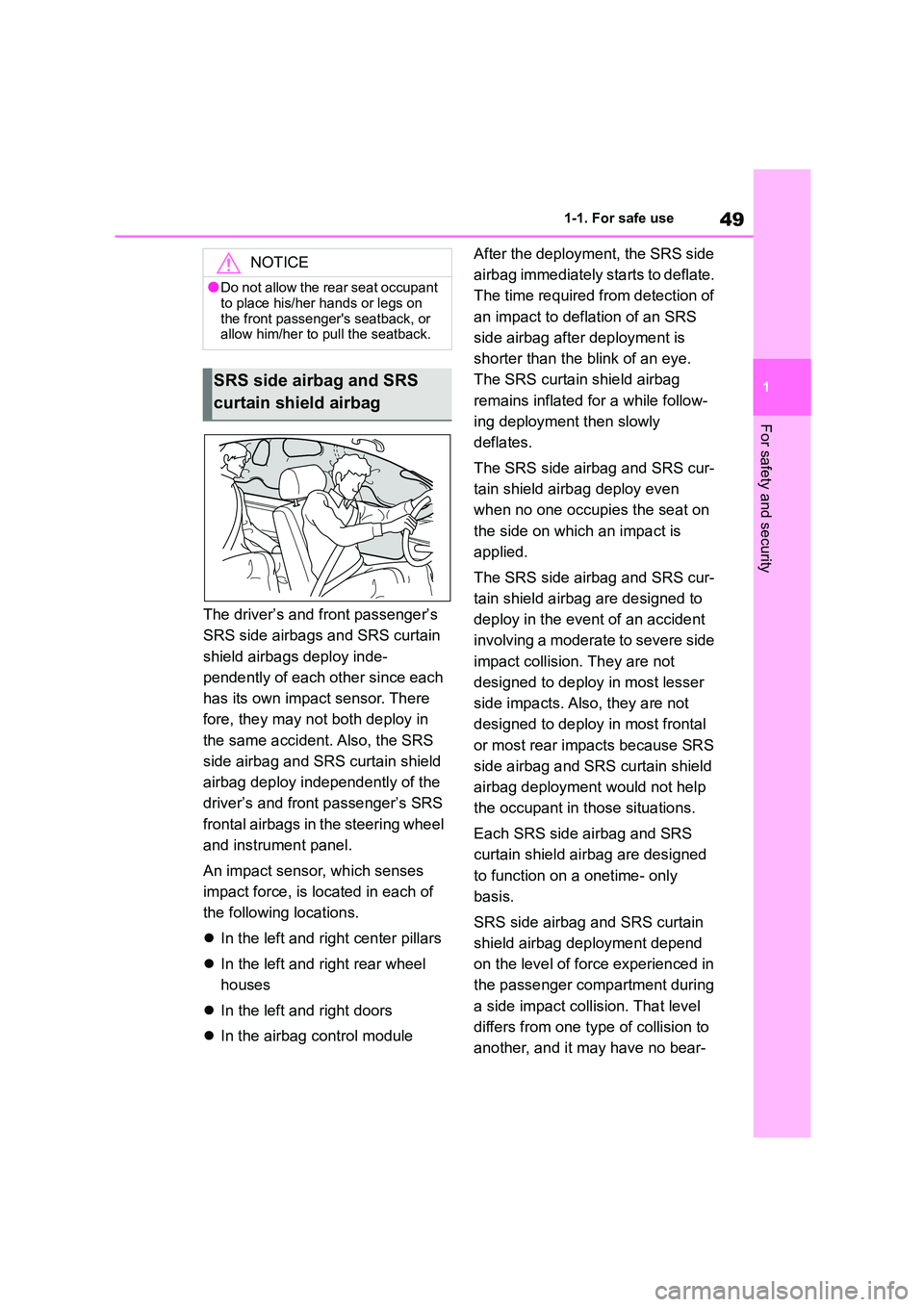
49
1
1-1. For safe use
For safety and security
The driver’s and front passenger’s
SRS side airbags and SRS curtain
shield airbags deploy inde-
pendently of each other since each
has its own impact sensor. There
fore, they may not both deploy in
the same accident. Also, the SRS
side airbag and SRS curtain shield
airbag deploy independently of the
driver’s and front passenger’s SRS
frontal airbags in the steering wheel
and instrument panel.
An impact sensor, which senses
impact force, is located in each of
the following locations.
In the left and right center pillars
In the left and right rear wheel
houses
In the left and right doors
In the airbag control module
After the deployment, the SRS side
airbag immediately starts to deflate.
The time required from detection of
an impact to deflation of an SRS
side airbag after deployment is
shorter than the blink of an eye.
The SRS curtain shield airbag
remains inflated for a while follow-
ing deployment then slowly
deflates.
The SRS side airbag and SRS cur-
tain shield airbag deploy even
when no one occupies the seat on
the side on which an impact is
applied.
The SRS side airbag and SRS cur-
tain shield airbag are designed to
deploy in the event of an accident
involving a moderate to severe side
impact collision. They are not
designed to deploy in most lesser
side impacts. Also, they are not
designed to deploy in most frontal
or most rear impacts because SRS
side airbag and SRS curtain shield
airbag deployment would not help
the occupant in those situations.
Each SRS side airbag and SRS
curtain shield airbag are designed
to function on a onetime- only
basis.
SRS side airbag and SRS curtain
shield airbag deployment depend
on the level of force experienced in
the passenger compartment during
a side impact collision. That level
differs from one type of collision to
another, and it may have no bear-
NOTICE
●Do not allow the rear seat occupant
to place his/her hands or legs on
the front passenger's seatback, or allow him/her to pull the seatback.
SRS side airbag and SRS
curtain shield airbag
Page 52 of 582
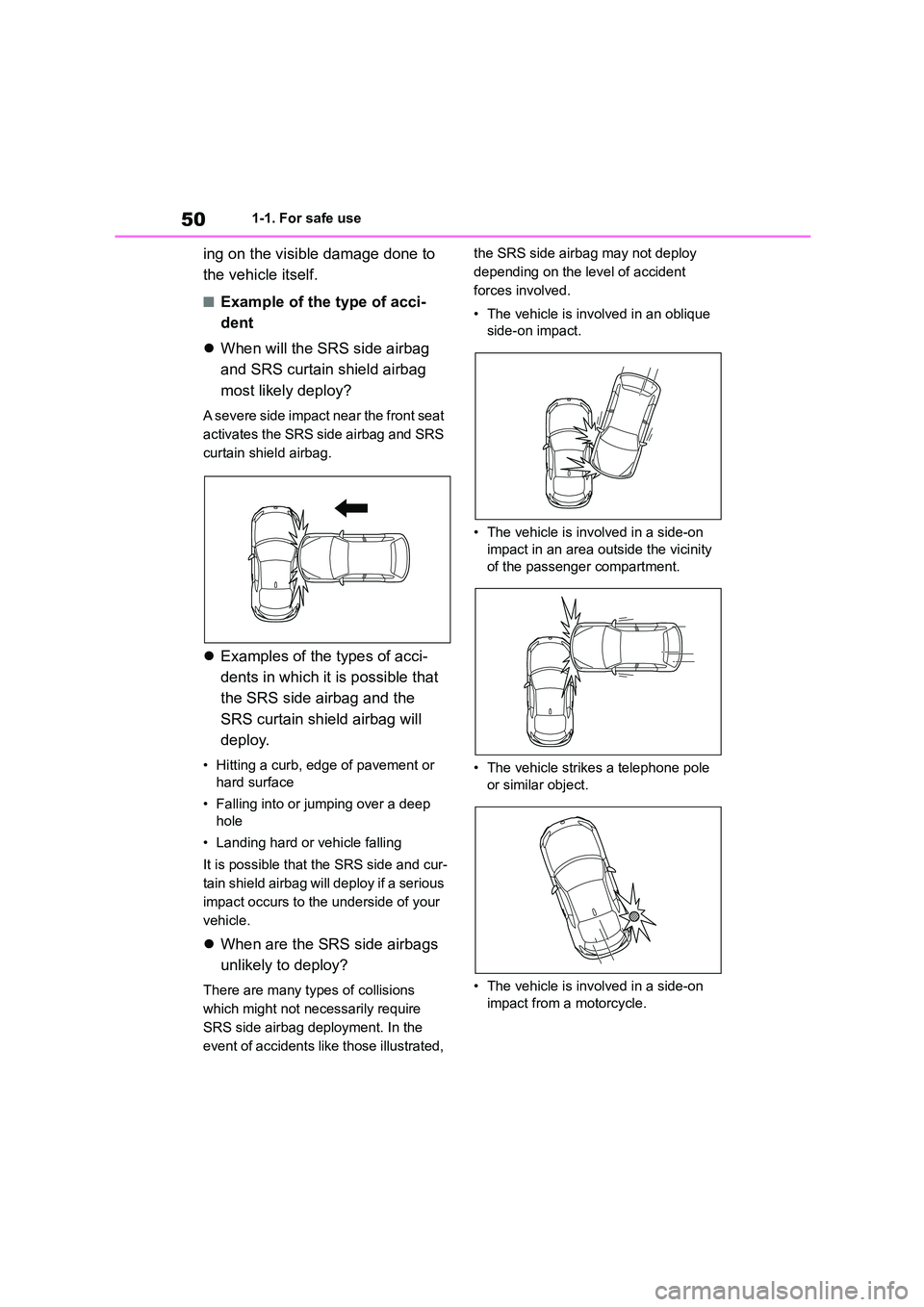
501-1. For safe use
ing on the visible damage done to
the vehicle itself.
■Example of the type of acci-
dent
When will the SRS side airbag
and SRS curtain shield airbag
most likely deploy?
A severe side impact near the front seat
activates the SRS side airbag and SRS
curtain shield airbag.
Examples of the types of acci-
dents in which it is possible that
the SRS side airbag and the
SRS curtain shield airbag will
deploy.
• Hitting a curb, edge of pavement or
hard surface
• Falling into or jumping over a deep
hole
• Landing hard or vehicle falling
It is possible that the SRS side and cur-
tain shield airbag will deploy if a serious
impact occurs to the underside of your
vehicle.
When are the SRS side airbags
unlikely to deploy?
There are many types of collisions
which might not necessarily require
SRS side airbag deployment. In the
event of accidents like those illustrated,
the SRS side airbag may not deploy
depending on the level of accident
forces involved.
• The vehicle is involved in an oblique
side-on impact.
• The vehicle is involved in a side-on
impact in an area outside the vicinity
of the passenger compartment.
• The vehicle strikes a telephone pole
or similar object.
• The vehicle is involved in a side-on
impact from a motorcycle.
Page 53 of 582
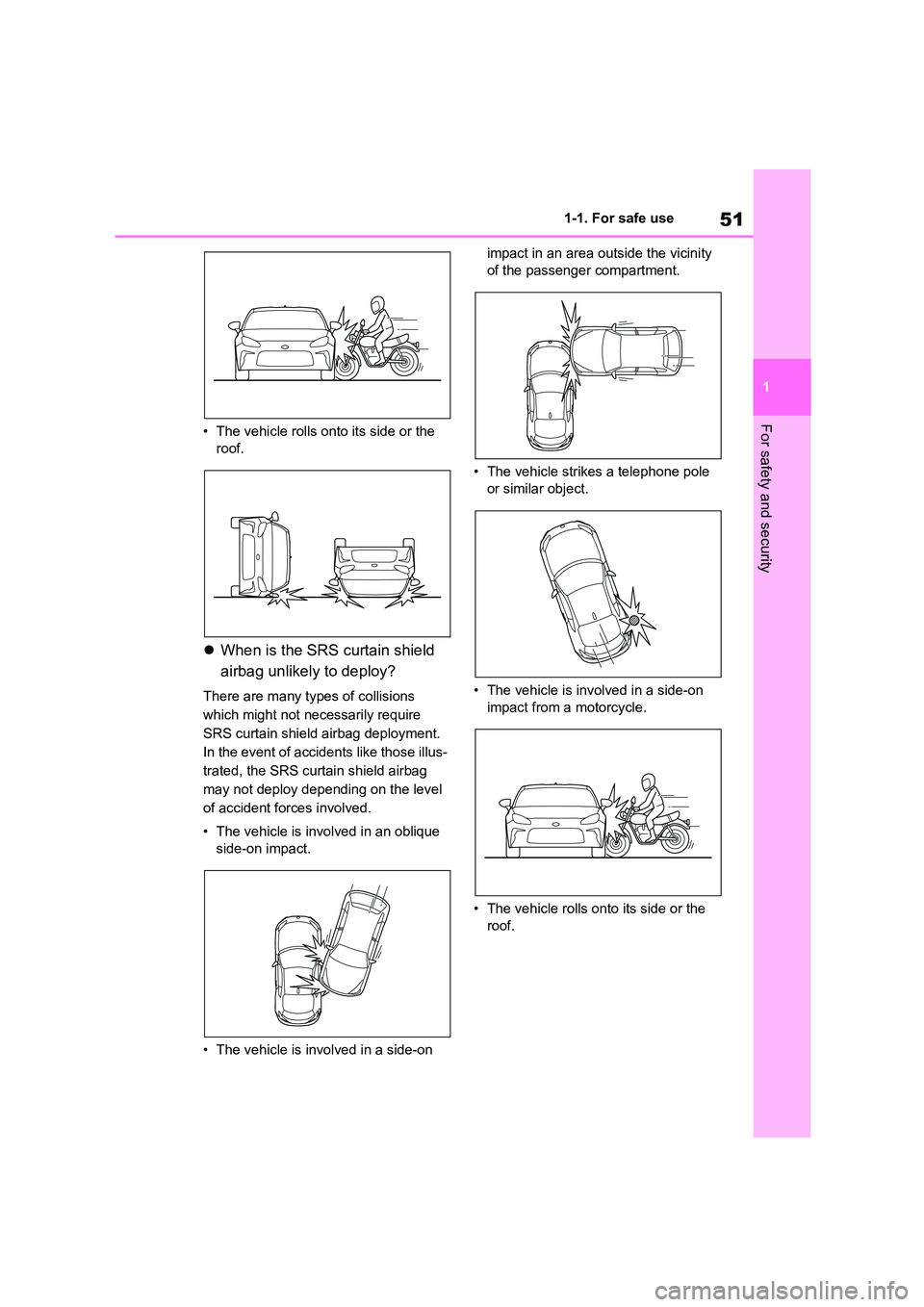
51
1
1-1. For safe use
For safety and security• The vehicle rolls onto its side or the
roof.
When is the SRS curtain shield
airbag unlikely to deploy?
There are many types of collisions
which might not necessarily require
SRS curtain shield airbag deployment.
In the event of accidents like those illus-
trated, the SRS curtain shield airbag
may not deploy depending on the level
of accident forces involved.
• The vehicle is involved in an oblique
side-on impact.
• The vehicle is involved in a side-on
impact in an area outside the vicinity
of the passenger compartment.
• The vehicle strikes a telephone pole
or similar object.
• The vehicle is involved in a side-on
impact from a motorcycle.
• The vehicle rolls onto its side or the
roof.
Page 54 of 582
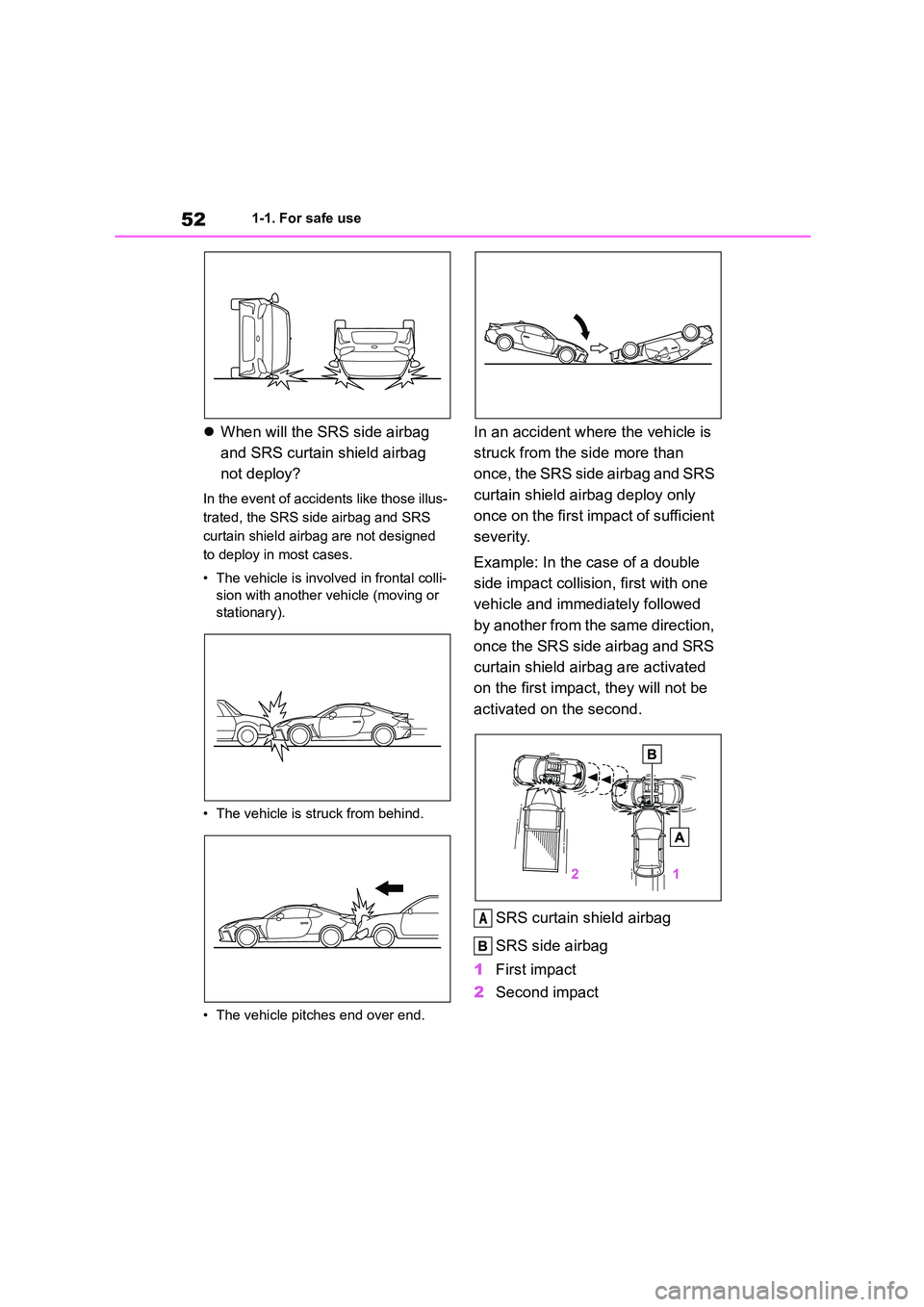
521-1. For safe use
When will the SRS side airbag
and SRS curtain shield airbag
not deploy?
In the event of accidents like those illus-
trated, the SRS side airbag and SRS
curtain shield airbag are not designed
to deploy in most cases.
• The vehicle is involved in frontal colli-
sion with another vehicle (moving or
stationary).
• The vehicle is struck from behind.
• The vehicle pitches end over end.
In an accident where the vehicle is
struck from the side more than
once, the SRS side airbag and SRS
curtain shield airbag deploy only
once on the first impact of sufficient
severity.
Example: In the case of a double
side impact collision, first with one
vehicle and immediately followed
by another from the same direction,
once the SRS side airbag and SRS
curtain shield airbag are activated
on the first impact, they will not be
activated on the second.
SRS curtain shield airbag
SRS side airbag
1 First impact
2 Second impact
A
Page 55 of 582
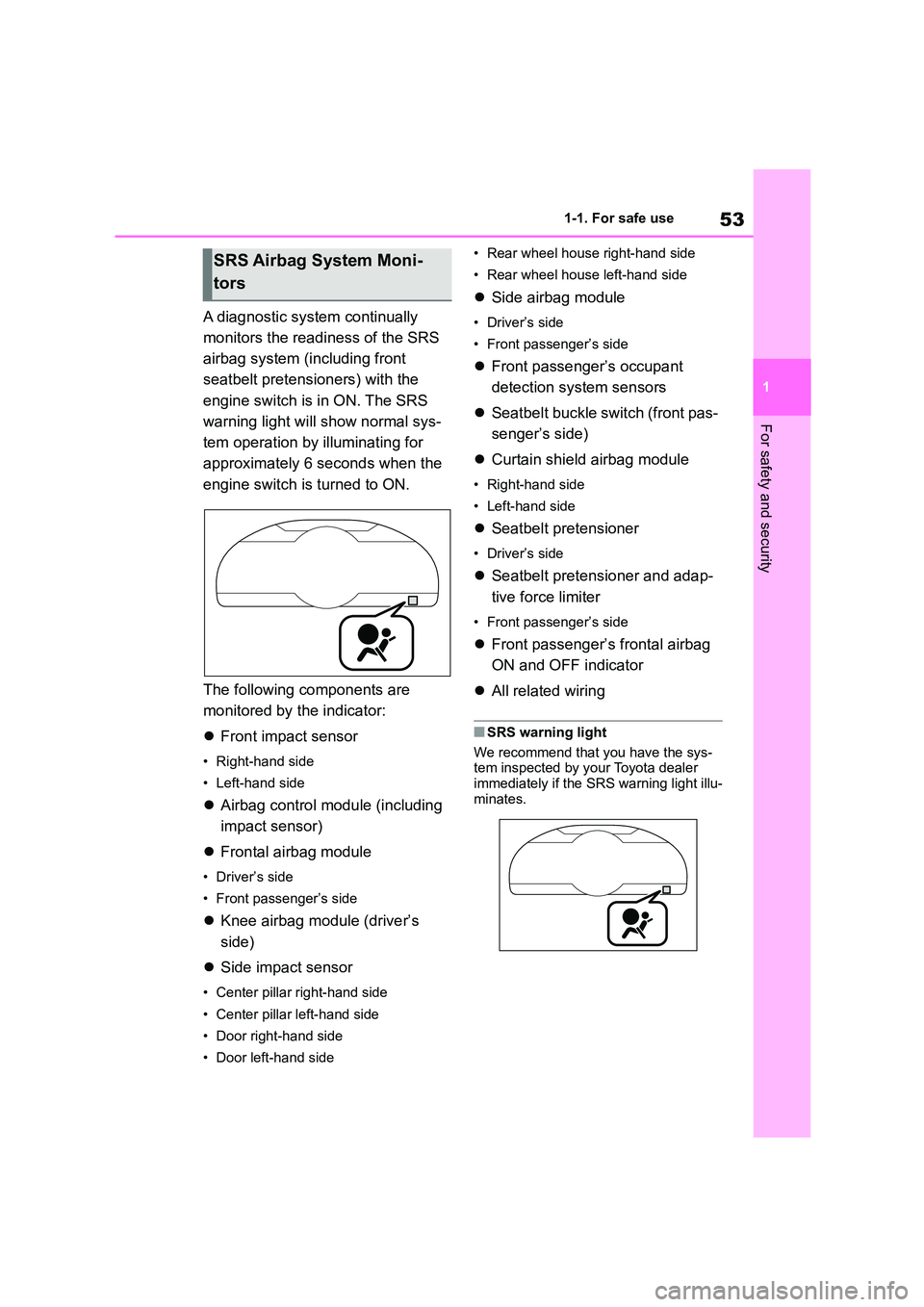
53
1
1-1. For safe use
For safety and security
A diagnostic system continually
monitors the readiness of the SRS
airbag system (including front
seatbelt pretensioners) with the
engine switch is in ON. The SRS
warning light will show normal sys-
tem operation by illuminating for
approximately 6 seconds when the
engine switch is turned to ON.
The following components are
monitored by the indicator:
Front impact sensor
• Right-hand side
• Left-hand side
Airbag control module (including
impact sensor)
Frontal airbag module
• Driver’s side
• Front passenger’s side
Knee airbag module (driver’s
side)
Side impact sensor
• Center pillar right-hand side
• Center pillar left-hand side
• Door right-hand side
• Door left-hand side
• Rear wheel house right-hand side
• Rear wheel house left-hand side
Side airbag module
• Driver’s side
• Front passenger’s side
Front passenger’s occupant
detection system sensors
Seatbelt buckle switch (front pas-
senger’s side)
Curtain shield airbag module
• Right-hand side
• Left-hand side
Seatbelt pretensioner
• Driver’s side
Seatbelt pretensioner and adap-
tive force limiter
• Front passenger’s side
Front passenger’s frontal airbag
ON and OFF indicator
All related wiring
■SRS warning light
We recommend that you have the sys-
tem inspected by your Toyota dealer
immediately if the SRS warning light illu-
minates.
SRS Airbag System Moni-
tors
Page 56 of 582
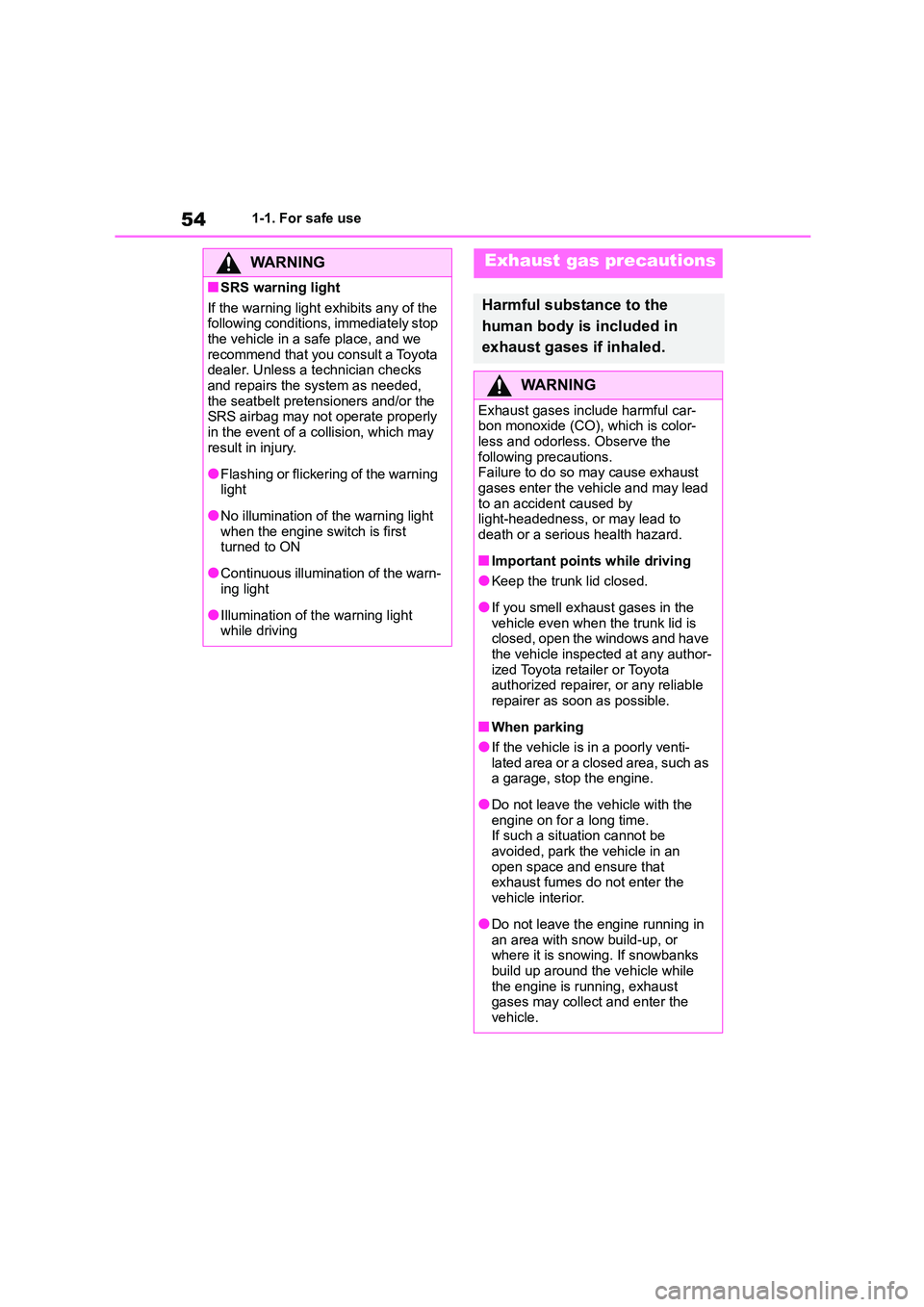
541-1. For safe use
WA R N I N G
■SRS warning light
If the warning light exhibits any of the
following conditions, immediately stop the vehicle in a safe place, and we
recommend that you consult a Toyota
dealer. Unless a technician checks and repairs the system as needed,
the seatbelt pretensioners and/or the
SRS airbag may not operate properly
in the event of a collision, which may result in injury.
●Flashing or flickering of the warning light
●No illumination of the warning light when the engine switch is first
turned to ON
●Continuous illumination of the warn-
ing light
●Illumination of the warning light
while driving
Exhaust gas precautions
Harmful substance to the
human body is included in
exhaust gases if inhaled.
WA R N I N G
Exhaust gases include harmful car-
bon monoxide (CO), which is color-
less and odorless. Observe the following precautions.
Failure to do so may cause exhaust
gases enter the vehicle and may lead to an accident caused by
light-headedness, or may lead to
death or a serious health hazard.
■Important points while driving
●Keep the trunk lid closed.
●If you smell exhaust gases in the
vehicle even when the trunk lid is closed, open the windows and have
the vehicle inspected at any author-
ized Toyota retailer or Toyota authorized repairer, or any reliable
repairer as soon as possible.
■When parking
●If the vehicle is in a poorly venti-
lated area or a closed area, such as a garage, stop the engine.
●Do not leave the vehicle with the engine on for a long time.
If such a situation cannot be
avoided, park the vehicle in an open space and ensure that
exhaust fumes do not enter the
vehicle interior.
●Do not leave the engine running in
an area with snow build-up, or where it is snowing. If snowbanks
build up around the vehicle while
the engine is running, exhaust gases may collect and enter the
vehicle.
Page 57 of 582
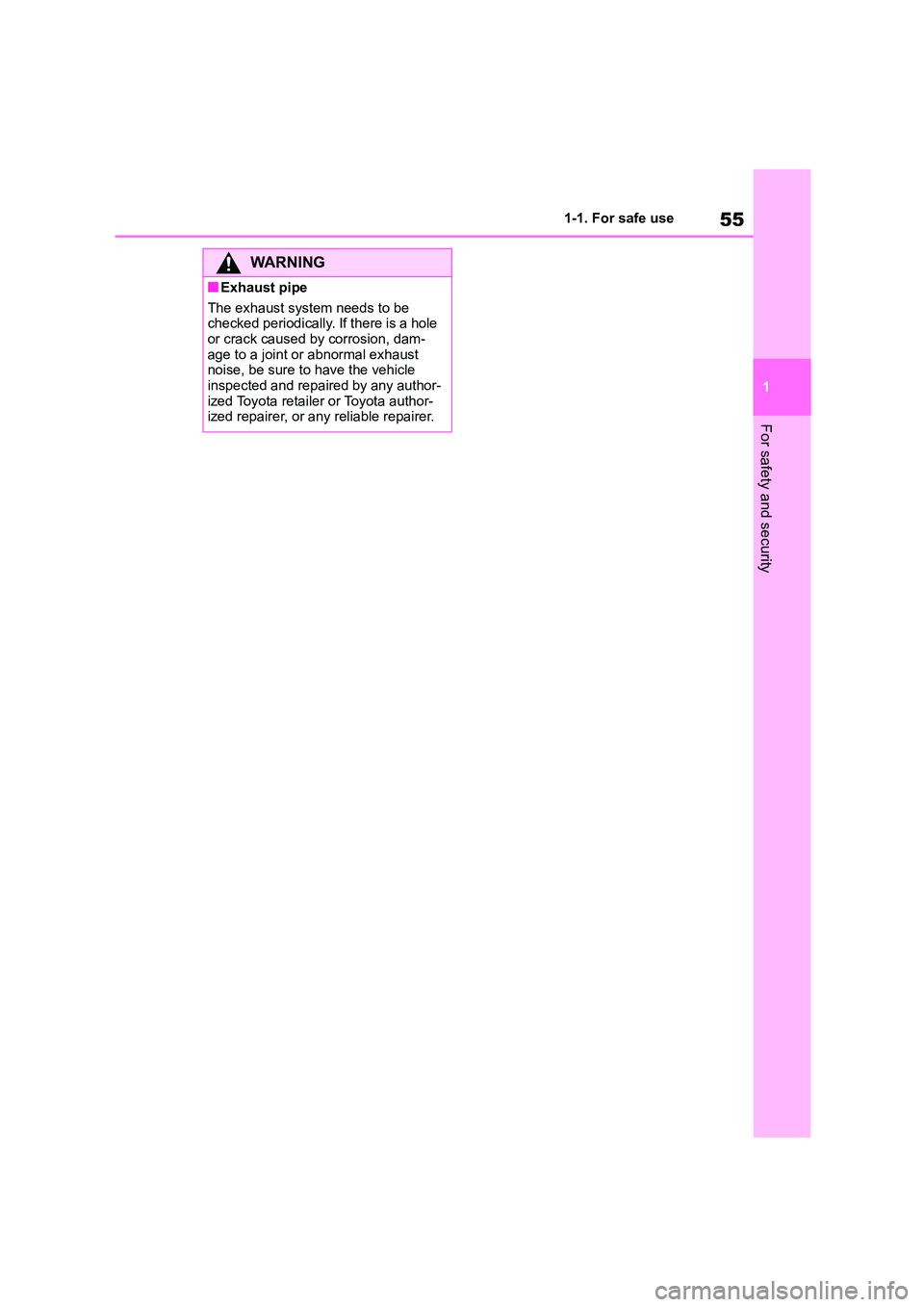
55
1
1-1. For safe use
For safety and security
WA R N I N G
■Exhaust pipe
The exhaust system needs to be
checked periodically. If there is a hole or crack caused by corrosion, dam-
age to a joint or abnormal exhaust
noise, be sure to have the vehicle inspected and repaired by any author-
ized Toyota retailer or Toyota author-
ized repairer, or any reliable repairer.
Page 58 of 582
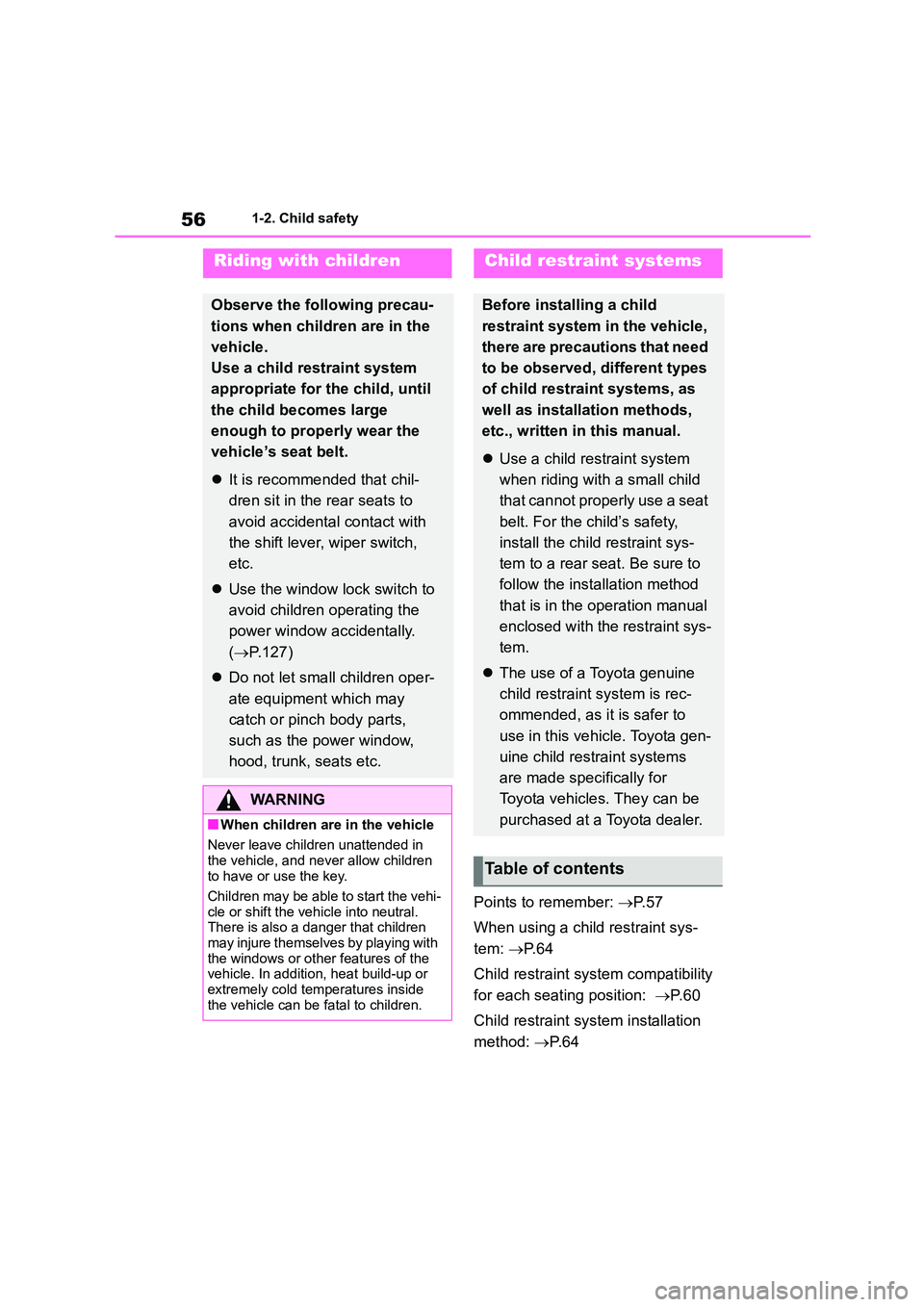
561-2. Child safety
1-2.Child safety
Points to remember: P. 5 7
When using a child restraint sys-
tem: P. 6 4
Child restraint sys tem compatibility
for each seating position: P. 6 0
Child restraint sys tem installation
method: P. 6 4
Riding with children
Observe the following precau-
tions when children are in the
vehicle.
Use a child restraint system
appropriate for the child, until
the child becomes large
enough to properly wear the
vehicle’s seat belt.
It is recommended that chil-
dren sit in the rear seats to
avoid accidental contact with
the shift lever, wiper switch,
etc.
Use the window lock switch to
avoid children operating the
power window accidentally.
( P.127)
Do not let small children oper-
ate equipment which may
catch or pinch body parts,
such as the power window,
hood, trunk, seats etc.
WA R N I N G
■When children are in the vehicle
Never leave children unattended in
the vehicle, and never allow children to have or use the key.
Children may be able to start the vehi-
cle or shift the vehicle into neutral. There is also a danger that children
may injure themselves by playing with
the windows or other features of the vehicle. In addition, heat build-up or
extremely cold temperatures inside
the vehicle can be fatal to children.
Child restraint systems
Before installing a child
restraint system in the vehicle,
there are precautions that need
to be observed, different types
of child restraint systems, as
well as installation methods,
etc., written in this manual.
Use a child restraint system
when riding with a small child
that cannot properly use a seat
belt. For the child’s safety,
install the child restraint sys-
tem to a rear se at. Be sure to
follow the insta llation method
that is in the operation manual
enclosed with the restraint sys-
tem.
The use of a Toyota genuine
child restraint system is rec-
ommended, as it is safer to
use in this vehicle. Toyota gen-
uine child restraint systems
are made specifically for
Toyota vehicles. They can be
purchased at a Toyota dealer.
Table of contents
Page 59 of 582
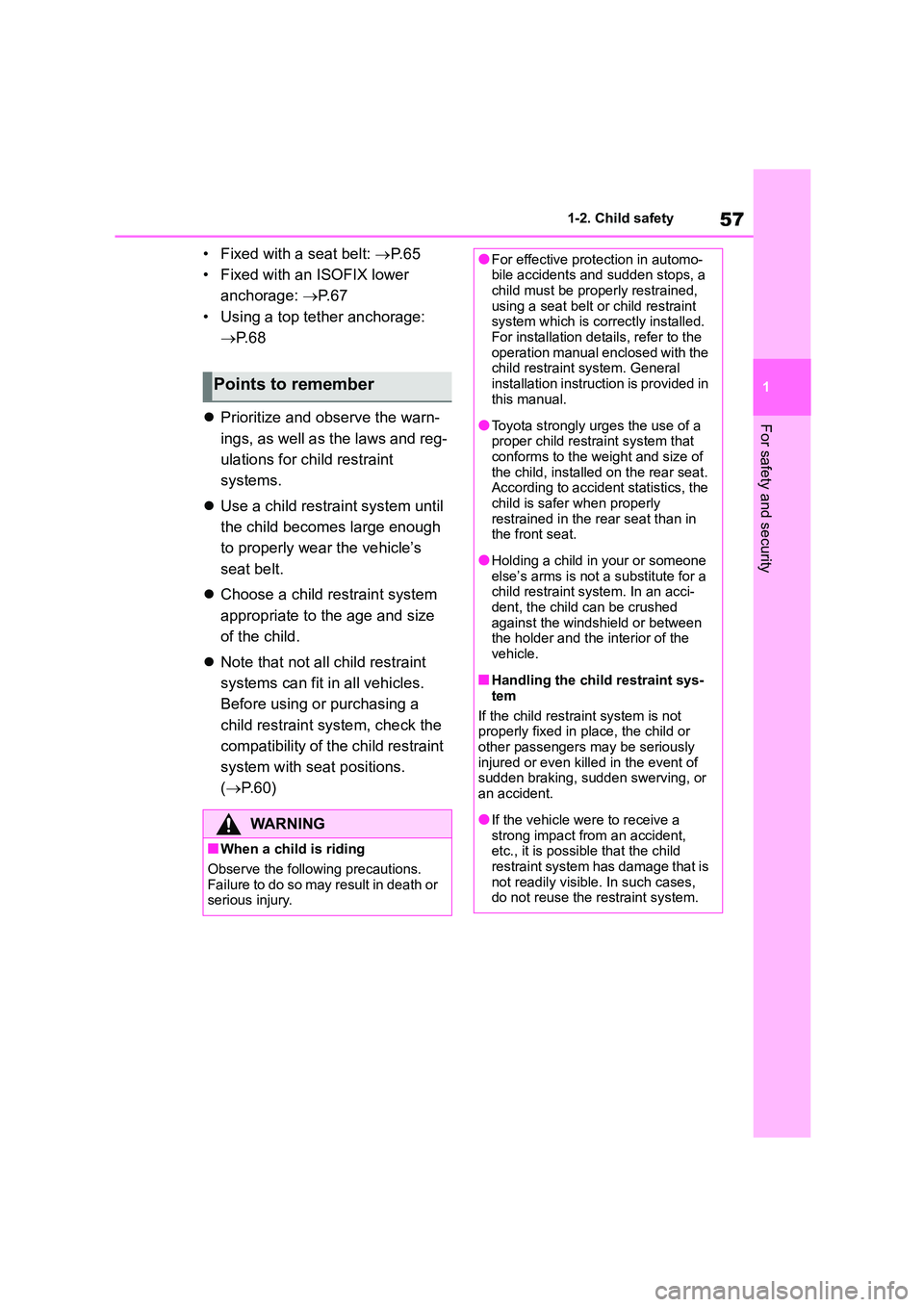
57
1
1-2. Child safety
For safety and security
• Fixed with a seat belt: P. 6 5
• Fixed with an ISOFIX lower
anchorage: P. 6 7
• Using a top tether anchorage:
P. 6 8
Prioritize and observe the warn-
ings, as well as the laws and reg-
ulations for child restraint
systems.
Use a child restraint system until
the child becomes large enough
to properly wear the vehicle’s
seat belt.
Choose a child restraint system
appropriate to the age and size
of the child.
Note that not all child restraint
systems can fit in all vehicles.
Before using or purchasing a
child restraint system, check the
compatibility of th e child restraint
system with seat positions.
( P. 6 0 )
Points to remember
WA R N I N G
■When a child is riding
Observe the following precautions.
Failure to do so may result in death or
serious injury.
●For effective protection in automo- bile accidents and sudden stops, a
child must be properly restrained,
using a seat belt or child restraint system which is corr ectly installed.
For installation details, refer to the
operation manual enclosed with the child restraint system. General
installation instruction is provided in
this manual.
●Toyota strongly urges the use of a
proper child rest raint system that conforms to the weight and size of
the child, installed on the rear seat.
According to accident statistics, the child is safer when properly
restrained in the rear seat than in
the front seat.
●Holding a child in your or someone
else’s arms is not a substitute for a child restraint system. In an acci-
dent, the child can be crushed
against the windshield or between the holder and the interior of the
vehicle.
■Handling the child restraint sys-
tem
If the child restraint system is not properly fixed in place, the child or
other passengers may be seriously
injured or even killed in the event of sudden braking, sudden swerving, or
an accident.
●If the vehicle were to receive a
strong impact from an accident,
etc., it is possible that the child restraint system has damage that is
not readily visible. In such cases,
do not reuse the restraint system.
Page 60 of 582
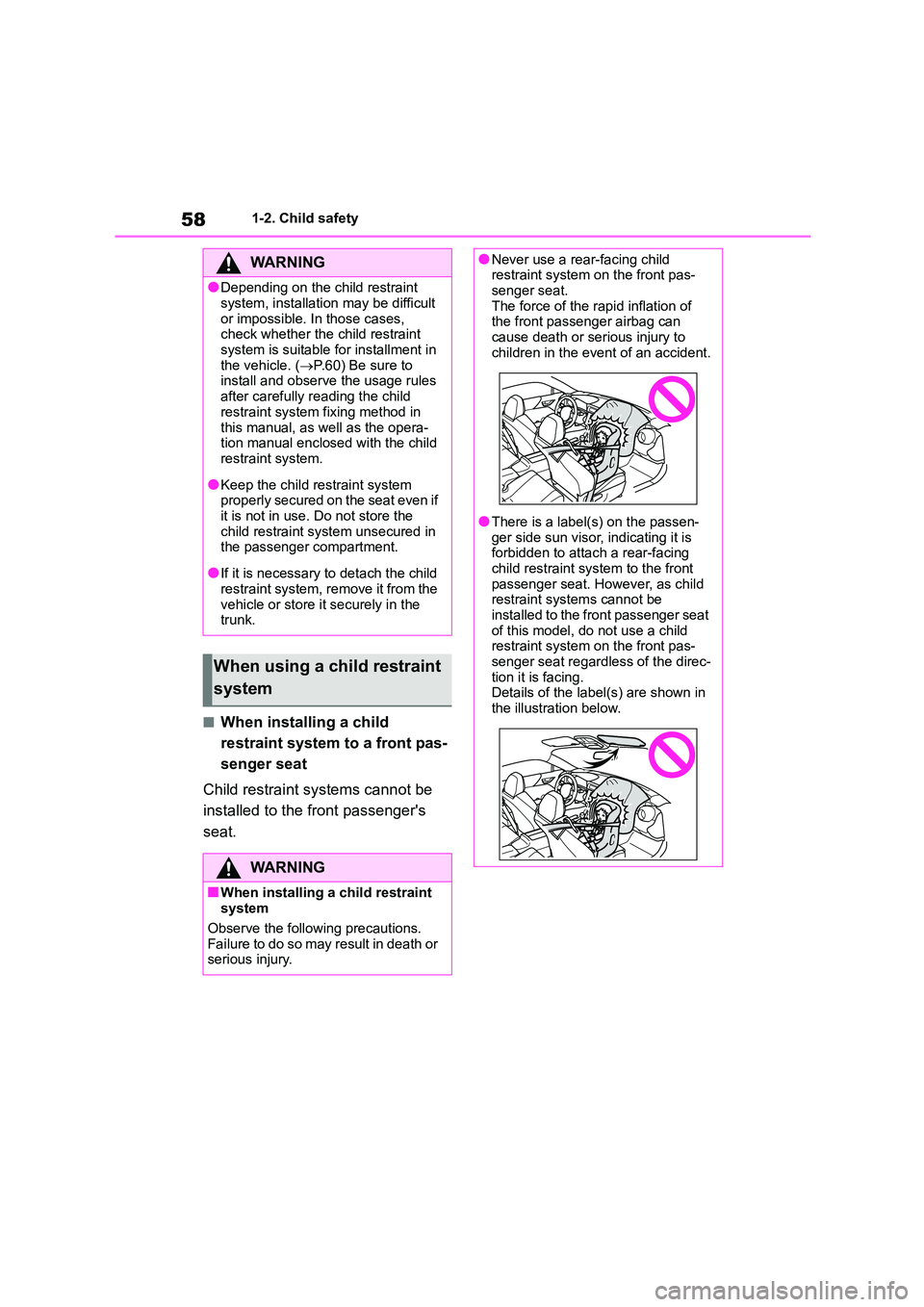
581-2. Child safety
■When installing a child
restraint system to a front pas-
senger seat
Child restraint systems cannot be
installed to the front passenger's
seat.
WA R N I N G
●Depending on the child restraint
system, installation may be difficult
or impossible. In those cases, check whether the child restraint
system is suitable for installment in
the vehicle. ( P.60) Be sure to install and observe the usage rules
after carefully reading the child
restraint system fixing method in
this manual, as well as the opera- tion manual enclosed with the child
restraint system.
●Keep the child re straint system
properly secured on the seat even if
it is not in use. Do not store the child restraint system unsecured in
the passenger compartment.
●If it is necessary to detach the child
restraint system, remove it from the
vehicle or store it securely in the trunk.
When using a child restraint
system
WA R N I N G
■When installing a child restraint
system
Observe the following precautions. Failure to do so may result in death or
serious injury.
●Never use a rear-facing child restraint system on the front pas-
senger seat.
The force of the rapid inflation of the front passenger airbag can
cause death or serious injury to
children in the event of an accident.
●There is a label(s) on the passen-
ger side sun visor, indicating it is forbidden to attach a rear-facing
child restraint system to the front
passenger seat. However, as child restraint systems cannot be
installed to the front passenger seat
of this model, do not use a child restraint system on the front pas-
senger seat regardless of the direc-
tion it is facing. Details of the label(s) are shown in
the illustration below.